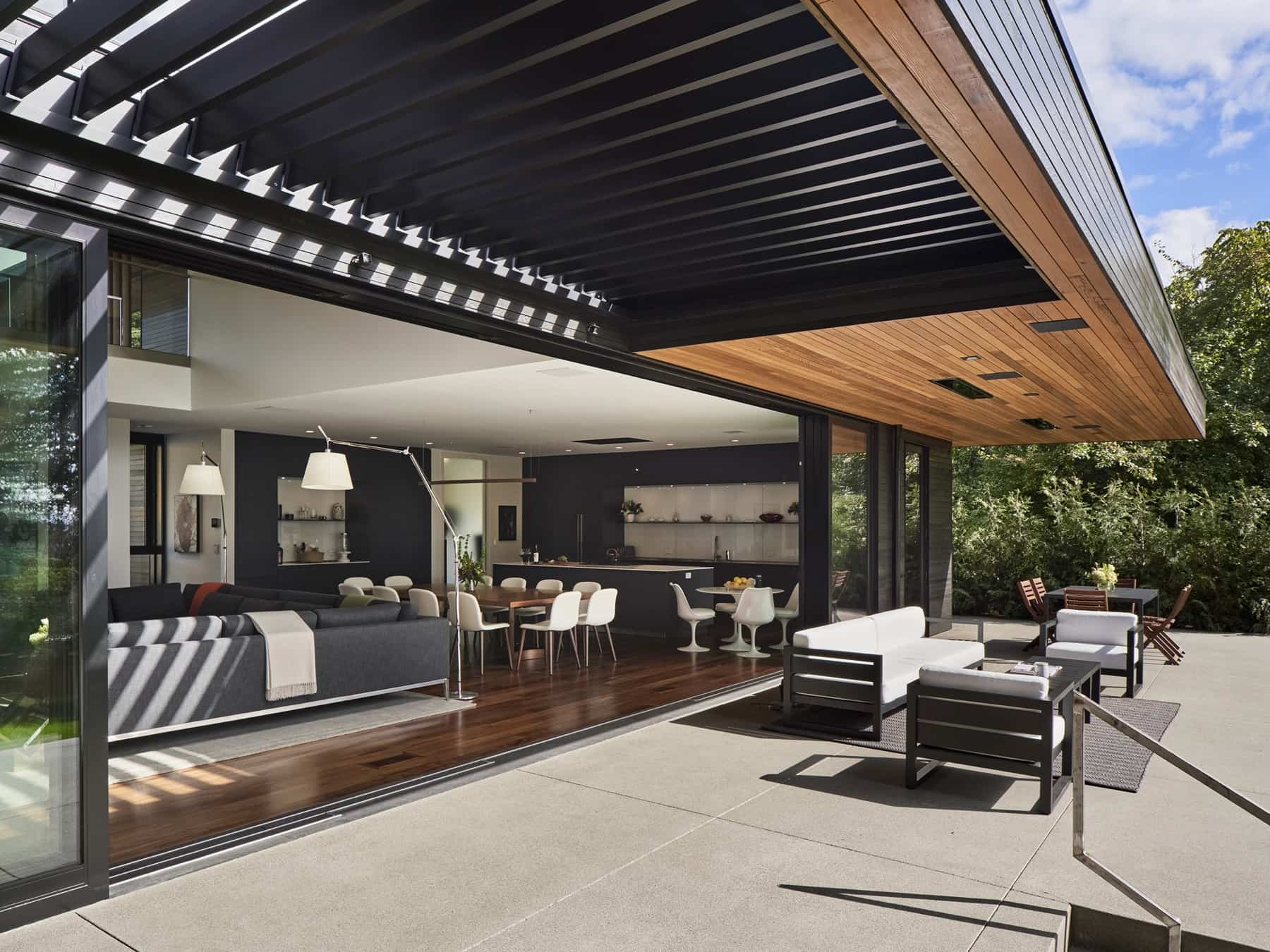For architects: how quality contractors build the modern house
Architects and designers know building science—and so should their builder, especially with the complexities of building a custom, contemporary home. Building decisions and their details such as sound, weather protection, air circulation, HVAC, and lower construction tolerances are often left primarily to the builder. Builders need to know how to get the best results while staying true to design integrity.
In this article, we offer recommendations about where to pay attention as you choose and work with a builder for the modern home.
What to know about air circulation and water protection for modern homes
Protection of the home from various outdoor elements such as windy and wet weather may be the most critical area of all. Not only does the builder make a lot of the choices here, but the quality processes are often left solely to the builder. Rarely does a building inspector or an architect review the work in progress.
As architects and designers know, the conventional house with its ventilated attic, is a more straight-forward way to build. Air is circulated, pulling fresh air from ventilation soffits under the eaves and into an attic space, escaping up through a vented roof.
In contrast, most modern roofs are now unvented, and these roof assemblies include the cathedral ceiling roof, shed or one-pitch roof, or a flat roof.
Architect: OH Architecture | Photography: KuDa Photography
In comparison to the vented roof, unvented roofs offer energy, durability and comfort advantages. We prefer to use a closed cell spray foam as we see it performs very well. When using closed cell spray foam, a builder needs to have a deep understanding of how to correctly install it. When the foam is not installed correctly, massive issues can happen such as mold, mildew and roof damage. We work with only trusted trade partners who are intimately familiar with non-vented roofs and how to install closed cell spray foam.
At Hamish Murray Construction, we know that architects know a lot about building science. It’s critical that your builder also knows. how to implement this science, as they are often the sole inspectors of their work.
With our Portland, Oregon rainy climate, many homeowners prefer to see a roof that slopes, such as a shed roof, but we also appreciate the popularity and aesthetics of the modern flat roof. At minimum, a “flat” roof needs to have some slope, even if not detected by the eye.
Architect: Christie Architecture LLC | Photography: KuDa Photography
Choosing the right protective materials is critical for any modern roof, whether flat, shed, or some type of gable or hip roof. For example, if the roof pitch is less than a 3/12, which happens often for a modern home design, then it may warrant a metal roof, or a TPO roof, with single-ply thermoplastic polyolefin material that forms into one large piece. Or, sometimes the design aesthetic calls for a composite shingle roof even if it’s not generally recommended for a low pitched roof. Our trade partners will know how best to protect that composite roof with flashing, crickets, underlayment synthetic, etc., so the home is protected while honoring the architectural integrity.
What to Know about modern house overhangs; how will it be supported?
Today’s modern house often includes deep overhangs. We see its benefits; it shields a home’s siding and windows from the driving rain, provides shade from glaring direct sunlight, and creates a sheltered patio area to enjoy the outdoors.
You, the architect, know that a large overhang needs structural support, such as cantilevering into the home, or the use of a steel frame. We have seen how collaborating with an experienced builder on the small details pays off for identifying the best structural options and keeping an eye on the budget.
Architect: Scott Edwards Architecture | Photography: KuDa Photography
If a large overhang is vented, it is important to rely on a trustworthy roofer. Intake design and the roofing venting is often left up to the general contractor and roofer. It’s critical to create a well-founded intake system for these large overhangs to avoid issues in the attic.
What to know about modern sliding doors; tolerance is key
A modern house with its large windows can be breathtaking. However, installing large walls of glass and/or sliding doors has almost no room for tolerance. The industry standards of tolerances are not a helpful guideline, which allow a 1/2” tolerance for any 32” horizontal measurement. When doors are 8 feet or more, you need to be within 1/8” of level or it will not work! Also, the structure above that door needs to remain strong and rigid so it can’t sag over time. Doing the install right the first time is crucial.
Having experience with certain window and door products really helps. It’s always good when the builder has worked with a product line in the past. We’re always willing to try a new product, but it’s certainly easier to endorse if it’s tried-and-true.
These window walls can be expensive. The old saying “you get what you pay for” can be very true. If a client’s budget will not afford the more expensive products, it’s important to set expectations. Some lower-priced walls may be more cumbersome and heavier to open and close.
Sliding doors are even more interesting to install in a home remodel, as the years of settling can make things become quite out of plumb. It takes some creative work to trim it out to straighten it out. But it can be done with a careful eye to all critical details.
What to know about structural support and utilities when building a great room
When there is a big open room, architects know to rely on the engineer for load bearing walls, roof framing and beams. Then there’s the consideration of utility placement. We have often been brought in as a collaborator for both the utilities and the structural options. Great rooms may not be as easy to maintain for heating and cooling so HVAC plans need specific consideration. It’s often worth getting the input from an HVAC expert before construction begins.
Architect: Paul McKean Architecture LLC | Photography: KuDa Photography
Architects are strong in anticipating the engineering requirements. Yet, we find we bring value for solving some great room space complexities. We enjoy collaborating with architects so that change orders are kept to a minimum and the hidden parts of the home are worked out before construction.
What to know about reducing noise for a modern home
Sounds across a great room increase because of its sheer size, high ceilings and hardwood floors. Reducing reverberation may include installing open shelves (versus cabinets) and solid-core doors, and later decorating with large rugs and soft fabrics. With hardwood floors, sound travels to the floor below. And with any house, there are areas to consider reducing sound travel.
Architect: Scott Edwards Architecture | Photography: KuDa Photography
There are many noise reduction options. Choosing the right solutions are a matter of the client’s budget. We will be happy to discuss possible issues and solutions so that a client can know what to expect and make decisions before construction begins.
Tell us about what’s important to you.
At Hamish Murray Construction Inc., we seek to build each project on schedule and on budget, and always with top-notch quality results. We solely work with independent architects and designers, and we build long-term lasting relationships. We recognize your creative genius and your important role in the success of each project that we undertake.
Contact us
We’d love to meet you. Contact us or call us at (503) 460-7203 with questions you have, or ask us about our philosophy, experience, or any other question that is on your mind.
#modernhomes #buildingscience #architectbuilder #morethanabuilder #contractorcriteria #builderinsightsforrarchitects #modernroofs #unventedroofs #soundproofing #windowwalls

